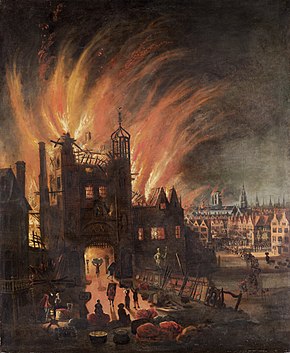When the Lie Becomes the Truth: The Popish Plot (1678 - 1681)
Although Charles II had been welcomed back after the rigours of life under The Lord Protector, his marriage to the Catholic Catherine of Portugal, his alliance with the old enemy France against Protestant Holland, and the embracing of his brother and heir James, Duke of York, of Catholicism, all led to there being much suspicion as to where the king’s loyalties lay, in terms of religion. His lenient attitude towards and treatment of Catholics had not gone down well with his people, and they worried that on his death they could be left with a Catholic King.
Sometimes, into such a cauldron of worry and paranoia the tiniest match has to be dropped to set the whole thing off, and two men who had many reasons to hate Catholics, one of which was believed to be actually insane, somehow gained the trust of the authorities, whipped up the public into a frenzy, and engineered the execution of innocent men, including priests, and one man who would later be canonised by the Church.
And it was all a lie.
 Titus Oates (1649 - 1705)
Titus Oates (1649 - 1705)
One of the two instigators of the plot, Oates was an English priest, and a poor one. A terrible scholar, he only managed to be ordained due to a false claim to have a degree (oddly enough, its production was never demanded and its existence seems to have been taken on trust by the Bishop of London, who ordained him) and later got into trouble while serving aboard a naval ship and being accused of “buggery” in Tangiers. Only his status as a priest saved him, but he was dismissed from the Navy. Prior to this incident, he had, while serving as curate in All Saint’s, Hastings, accused a teacher of sodomy with one of his pupils, completely baselessly, in order to take his job, and when the allegations proved groundless was himself accused of perjury.
Having been ordained into the Church of England in 1670 Oates, after some misadventures and after making some powerful enemies, switched his allegiances and became a Catholic priest seven years later. He met and cultivated the friendship of Israel Tonge, and together they authored anti-Catholic pamphlets, Oates later confiding to Tonge that he had only pretended to convert in order to get close to Catholics and learn their secrets. Between them they concocted the Popish Plot in 1678.
Israel Tonge (1621 - 1680)
A Doctor of Theology, Tonge blamed Catholic Jesuits for the burning down of his church during the Great Fire of London, He became even more anti-Catholic, writing tracts and essays denouncing them, and fabricating wild conspiracy theories about Rome’s lust for power and the danger of the Pope. Another rabidly anti-Catholic doctor, Richard Barker, sponsored him (and later, Oates), providing him with food, lodgings and money, and securing for him a position as rector in the parish of Avon Dasset, in Warwickshire, a post Tonge did not however accept.
Together these two men would create a conspiracy to rival the best of Qanon or any in Trump’s time. Completely fabricated, with no evidence or provenance whatever, it would still be accepted as legitimate and lead to the further persecution and death of many blameless Catholics.
Writing the manuscript himself, Oates laid out a plot by the Pope to have the king assassinated, naming Jesuit priests who were to carry out the attempt, about a hundred in all. He then slipped the note into the house of Richard Barker, where his friend Tonge was living. Tonge then “discovered” the writing, passed it on to his friend Christopher Kirkby, who became alarmed and informed the king. Charles was sceptical, but agreed to see Tonge and Oates, then passing the matter on to his Treasurer, Thomas Osborne, Lord Danby. Danby seemed convinced, but the king brushed the whole thing off, believing Oates a liar. The Duke of York, however, fearful for his brother’s life and knowing (though he was himself a Catholic) how vehemently opposed to the Church of England English Catholics were, ordered an investigation into the threat.
Though Charles was still reluctant and did not believe a word of it, he probably worried that ignoring the threat might make him look overly sympathetic to Catholics, further cementing in the minds of his subjects his untrustworthiness, and recalling to their memory the fact that he was married to a Catholic princess. Therefore, he agreed to the investigation, and as it gathered steam and people were arrested on various spurious charges, Oates was given a complement of soldiers and allowed to begin rounding up Jesuits. The murder of a prominent anti-Catholic minister in suspicious circumstances set things in proper motion.

Sir Edmund Berry Godfrey, to whom Oates had made his first depositions about the alleged plot, was found murdered with his own sword. The slaying was never solved, and laid at the feet of unnamed Catholics. As a result, and with the supposedly genuine threat of an attempt on the king’s life by these heathens, Charles was prevailed upon to exile all Catholics to within twenty miles of London. Parliament issued the declaration that "This House is of opinion that there hath been and still is a damnable and hellish plot contrived and carried out by the popish recusants for assigning and murdering the King." Things began to move fast.
Oates seized upon his success and accused five Catholic lords: (William Herbert, 1st Marquess of Powis, William Howard, 1st Viscount Stafford, Henry Arundell, 3rd Baron Arundell of Wardour, William Petre, 4th Baron Petre and John Belasyse, 1st Baron Belasyse) and while the king scornfully maintained that at least one of them was so afflicted with gout that he could barely stand, and was unlikely to be plotting anything, the Earl of Shaftesbury had them all arrested and taken to the Tower. Shortly afterwards he demanded that the king’s brother, James, Duke of York, be excluded from succession to the throne, due to his Catholic allegiances. At the end of the year the second Test Act was passed, as anti-Catholic fervour swept through England, which forbade Catholics from sitting in either the House of Lords or the House of Commons, and so effectively banning them from holding any political office.
Two of the “Popish Lords” would die - Stafford beheaded while Petre simply died in the Tower - but the remaining three would be acquitted. However Catholic hysteria had descended on England long before this and as would happen in the Salem witch trials ten years later, accusations flew, unproven allegations were taken as evidence, and Catholics were persecuted, exiled and murdered.
 Oliver Plunkett (1625 - 1681)
Oliver Plunkett (1625 - 1681)
Last of Oates’ victims was a man who would go on to be canonised and therefore made a saint in the latter half of the twentieth century. Oliver Plunkett was Archbishop of Armagh, and Primate of All Ireland. The grandson of a Baron, he was well connected to powerful Irish families such as the Earls of Roscommon and the Lords of Louth. He travelled to Rome in 1647, his ambition to become a priest, but by the time he was ready to return Cromwell held sway over Ireland and it would have been death for him to set foot on his native land again, so he remained in Rome until 1670, when the Restoration returned Charles II to the throne and, for a time, a more tolerant attitude was observed by the Crown towards Catholics.
With the passing of the Test Act, however, his church was destroyed and he had to flee into hiding, refusing to be exiled. When the Archbishop of Dublin was arrested as part of Oates’ crazy conspiracy, Plunkett was accused of plotting a French invasion of England. He was arrested but Lord Shaftesbury, knowing he would never be convicted in Ireland, sent him to be held in Newgate Prison, where, despite the first trial collapsing on the grounds of the witnesses against Plunkett also being on the run, wanted men, and total lack of any evidence to convict, the second trial found him guilty and he was sentenced to be executed.
Much again like the Witch Trials would, the fervour for killing Catholics began to die down after this. This could be partly ascribed to the - mistaken - belief that all those who had plotted against the king (according to Oates and Tonge) had been dealt with, and that the danger to his royal person, and the kingdom, was passed, and partly, too, to accusation after accusation being made, each madder and more far-fetched than the last. Oates remained as zealous as ever, trying to extend the conspiracy he had created into Yorkshire, but the English were by now tired of his unfounded allegations, and many believed that some of those who had been accused and executed were in fact good and innocent men. It began to look more and more like one man’s evil quest for personal revenge, which was what it was, of course. As trials collapsed all over the place, and the king was finally able to step forward and pronounce the witch-hunt for what it was, Oates rather stupidly accused the king himself of plotting with Catholics, and was arrested and thrown into prison.
When Charles died and was succeeded by James, the new king - a Catholic, remember - had Oates tried for perjury, probably the best he could do. Found guilty, it was unfortunately impossible to sentence Oates to death for such a crime, so he was ordered to be whipped through the streets, pilloried every year and imprisoned for life. He was eventually released in 1689 when William of Orange became king, but by then everyone had forgotten about him and he faded out of history, from hero to zero.



 Trollheart!!! So good to see you here again!
Trollheart!!! So good to see you here again! 






 )
)





 Linear Mode
Linear Mode
